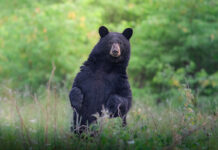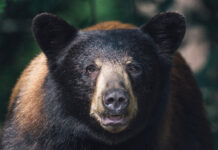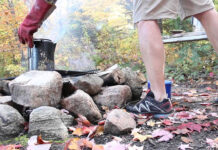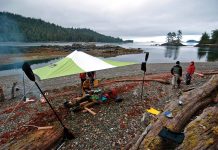To capture a 35-day crossing of Labrador last summer, I knew I needed a film kit up to the challenge of the province’s rugged terrain and temperamental weather. These items weigh just 15 pounds combined and fit into a Pelican 1500 waterproof case (excluding the solar kit).
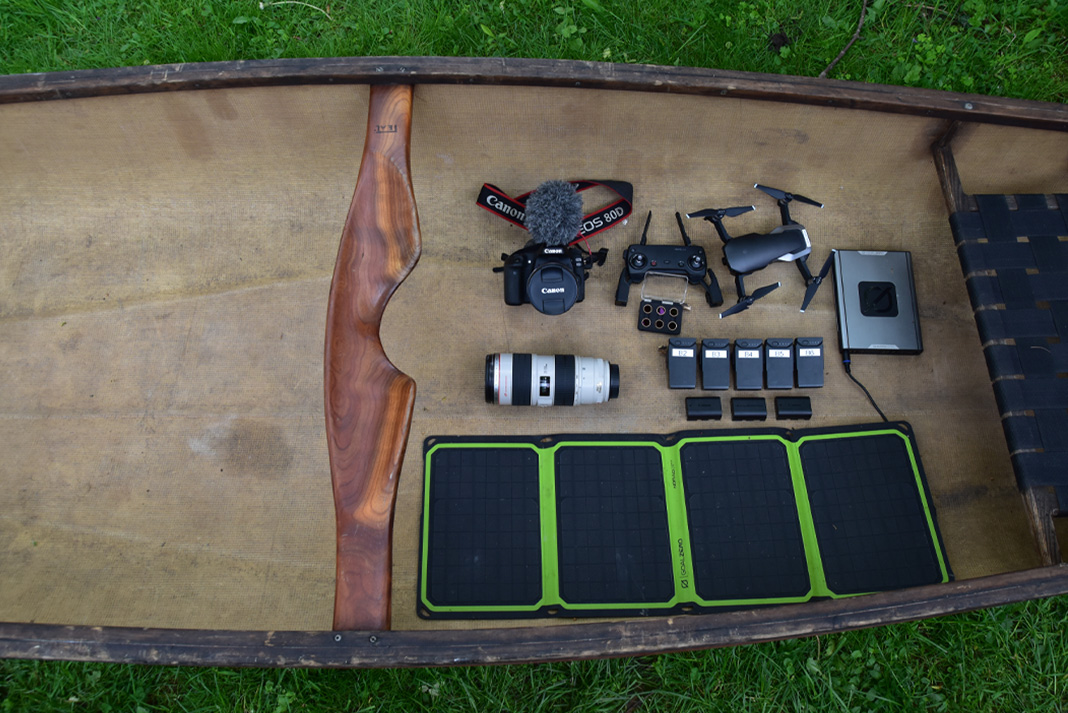
Canon 80D
I have paddled more than 1,000 miles with my 80D and still love shooting with it. Having a 24-megapixel sensor and shooting up to 1080/60p, this camera offers a good balance of photo and video quality, and left me with money to still go on trips. The only things it’s missing are the ability to shoot in 4K and an option to capture 120fps. These features exist on other models but are double the price.
$899 | canon.com
Canon EF 16-35mm f2.8 | Canon EF 70-200mm f2.8
Spending more money on lenses makes a significant difference in image quality. Filming in close quarters to capture campsite and in-canoe shots means a wide-angle lens is essential. Ninety percent of the time, I use the Canon 16-35mm f2.8 USM lens. The other 10 percent, I use my 70-200mm telephoto lens, perfect for capturing wildlife as well as getting b-roll shots, like fish rising out of the water or capturing emotion on someone’s face.
$1,999/ $1,799 | canon.com
Rode VideoMicro
I’ve learned the hard way not to shoot without a microphone. It can be tempting to skip this step when in a rush, but wind noise will leave some shots unusable. Opt for a mic with a furry wind shield like the Rode VideoMicro, perfect for its compact size, sound quality and price. Larger Rode products refer to the fluffy wind shield as a deadcat, but I’m fairly confident this is just a name and not a true material description.
$79 | rode.com
DJI Mavic Air
A drone adds an undeniably impressive perspective. I shoot with DJI’s Mavic Air because it practically fits in my pocket. While the image quality isn’t quite as high as the Mavic Pro 2, it still shoots in 4K, will reach the Canadian legal height of 120 meters, and shoots excellent slow-mo aerial footage. After our film was released, the drone footage of massive waterfalls and mountainous barrenlands received the most compliments.
$599 | dji.com
Canon LP-E6N | Mavic Air Intelligent Flight Battery
The Canon batteries hold their charge for an impressive amount of time, sometimes lasting up to two days while filming. I packed 10 of these batteries and also brought along a solar panel for recharging. The Intelligent Flight Battery for the Mavic Air caused me the most stress. Each battery only allows a maximum flight time of 15 minutes, and once the battery is below 30 percent, the drone won’t take off. I packed six batteries and planned out each shot before takeoff.
Canon $80 | DJI Mavic Air $79
PolarPro Cinema Series Mavic Air (6 Pack)
Neutral Density filters (ND filters) are essential to capture your image with the optimal exposures. Since the Mavic Air has a fixed aperture, carrying an ND filter gives you more control over your lighting, allowing you to lower your shutter speed.
$149 | polarprofilters.com
Goal Zero Nomad 28 & Sherpa 100
Carrying a solar kit and battery bank was worth the extra 4.5 pounds. In perfect sunny conditions, the Goal Zero Nomad 28 solar panels could fully charge the Sherpa 100 battery bank in eight to 10 hours on the canoe deck. Even though it rained for 28 of the 35 days, we managed to top up a charge by up to 20 percent on overcast days. The Sherpa 100 has USB ports to charge GPS, satellite phones and smartphones used to control the drone. Each used about 20 percent of the battery bank to charge. The Sherpa also has an AC outlet to charge Canon batteries, which used about 20 percent, and the Mavic Air batteries used closer to 40 percent. The Mavic Air charger is technically not compatible with the Sherpa 100, and it would sometimes cause the battery bank to overheat.
Nomad 28: $249 / Sherpa 100: $299 | goalzero.com
In 2019, Paddling Magazine staffer Alex Traynor was part of a four-person team paddling a 415-mile route across Labrador. Watch the 50-minute documentary Boreal to Barrenlands – Crossing Labrador on Vimeo or the in-depth video series at Youtube.com/northernscavenger.
This article was first published in Paddling Magazine Issue 62. Subscribe to Paddling Magazine’s print and digital editions here , or browse the archives here.
The cost of fame is an extra 15 pounds portaged on multiple six-mile height-of-land crossings. | Photo: Alex Traynor



